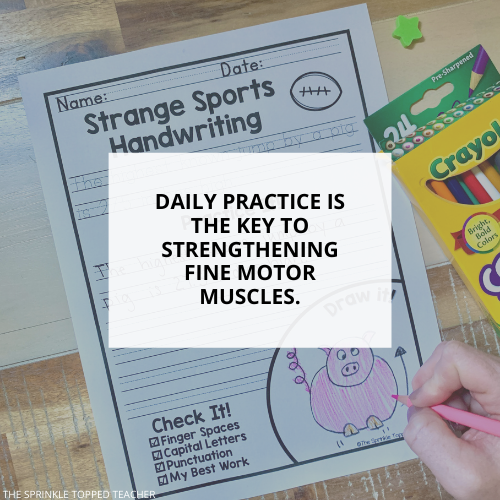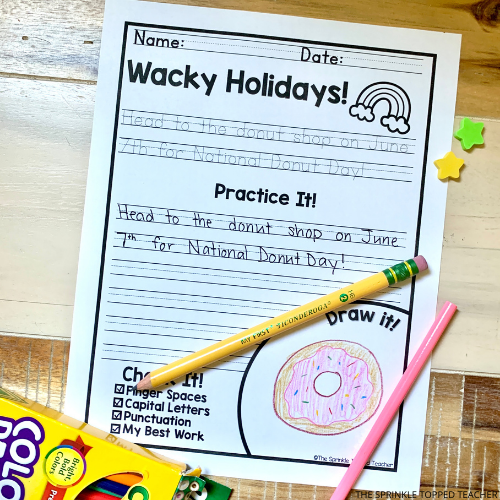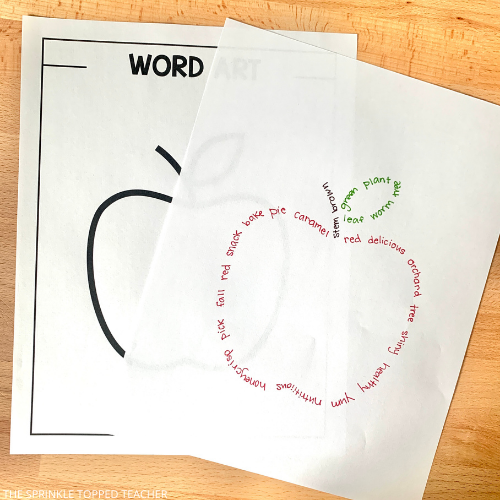
3 Easy Ways to Improve Kids’ Handwriting
Did you know that great handwriting skills are crucial to kids’ success throughout their years in school?
Writing skills are part of the foundation to good learning. Many studies have shown that students with great handwriting skills perform better in reading and math assessments, suggesting that handwriting is linked to academic success in a wide variety of subjects.
Plus, standardized tests often include writing assessments. Students who lack good handwriting skills aren’t able to demonstrate what they know as easily as other students.
The frustration that students feel when they can’t write well, can undermine their drive to succeed in academics down the road. It’s so important to get those skills up to par so that students have the best chance of success in school.

How do you improve kids’ handwriting?
When it comes to practicing handwriting skills, fine motor skills are everything. Fine motor skills are exercised when we move the little muscles in our hands and fingers.
It’s so important for little ones to regularly practice their fine motor skills, since they help them develop the ability to perform many tasks by themselves. These tasks include writing, eating, putting on and buttoning clothes, tying their shoes, and much, much more!
Daily practice is the key to strengthening fine motor muscles. For example, athletes need regular practice to maintain their strength and muscle memory. As a runner, if you take a week or even a few days off, getting back into the groove will feel much harder!
Students need to regularly work out those muscles in their hands to keep them strong and make it easier to write. In this digital and distance-learning age, practicing fine motor skills are more important than ever.
I’ve rounded up three of the most fun and easy ways to improve kids’ handwriting skills. These activities make handwriting fun, so kids can get the fine motor practice they need without getting bored. Both teachers and parents can use these ideas to help their kids with handwriting and set them up for academic success!

1. Mazes
Mazes are a fun way to strengthen those fine motor skills! Since mazes feel like a game, kids won’t even realize they’re working on their handwriting skills. As a bonus, mazes are also a great way to develop kids’ problem-solving and decision-making skills.
You can easily find mazes online to print for free. To best exercise their fine motor muscles, have your students or children try to complete the maze without touching the lines. They will have a blast while improving their handwriting!

2. Fun Handwriting Worksheets
Handwriting practice doesn’t have to mean boring alphabet pages. When kids get older, they especially dread handwriting worksheets.
These Silly Handwriting Worksheets make handwriting practice enjoyable, even for older students! Whether your kids or students are in first grade or sixth grade, they’ll look forward to handwriting practice with these worksheets.
The categories include a wide variety of topics so practice never gets old, including…
● Positive affirmations
● Gross facts
● Weird weather facts
● Strange holidays
● And more!
Kids will have a blast learning all sorts of facts while strengthening their fine motor muscles. This bundle includes assessments, goal setting, and even blank pages for students to create their own silly sentences. There’s even extra space at the end of each page for kids to draw the sentences they have written.
This practice is great for kids who already know how to form their letters, but can’t seem to slow down and write neatly. Plus, the bundle includes enough practice to last the whole school year!

3. Word Art Projects
Have your students or children create entertaining word art projects. All you have to do is print out a black and white lined image. Use any kind of clip art you want! Students will place a blank sheet of paper over the image and write words that match the category of the image to make the shape.
Word art projects are super fun for kids of all ages. Instead of just tracing images to practice fine motor skills, students can let their creativity shine by writing words that match an image’s category. For example, an image of an apple might inspire them to write “fruit”, “seed”, “tree”, or “red”. They can use colored pencils or markers to liven up their word art as well.
I recommend tying these word art projects into a reading or science unit, too! Simply match the photo to the theme of your unit.
Conclusion
These easy ways to improve kids’ handwriting are perfect for students of all ages. Whether you’re a teacher looking for classroom activity inspiration or a parent seeking extra practice for your child, these ideas are perfect for strengthening fine motor skills in kids. And remember, daily practice is key!
What is your favorite way to get students to practice handwriting? I’d love to hear your thoughts in the comments below!